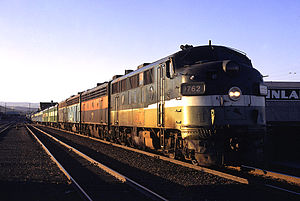EMD F3
| EMD F3 series | |
|---|---|
|
F3A, two cabless F3Bs and another F3A in front of the North Coast Hiawatha passenger train , 1971
|
|
| Manufacturer: | Electro-Motive Division |
| Year of construction (s): | 1946-1949 |
| Axis formula : | Bo'Bo ' |
| Gauge : | 1435 mm ( standard gauge ) |
| Length over coupling: | 15,544 mm |
| Service mass: | 104.3 t |
| Top speed: | 105 km / h to 160 km / h depending on the gear ratio |
| Hourly output : | 1,100 kW |
| Motor type: | EMD 567 B, 2-stroke diesel |
| Power transmission: | electric |
| Number of traction motors: | 4th |
The EMD F3 is a series of diesel-electric locomotives from the US locomotive manufacturer General Motors Electro-Motive Division . Originally designed as freight train locomotives, some examples were also used in passenger train service.
A total of 1,111 machines with a driver's cab (A units) and 696 B-units without a driver's cab were built. The last machines of the F3 were already delivered with the improved traction motors of the F7 and therefore given the nickname F5 . However, these machines were officially built under the designation F3.
development
EMD F2
In 1945 EMD further developed the EMD 567 diesel engine, which had been tried and tested in the previous FT series . The type designation EMD 567 meant that the engine had a displacement per cylinder of 567 cubic inches. The F-Series vehicles had 16-cylinder engines, while the EMD E-Series locomotives had two engine systems with 12 cylinders each. However, when the new engine was introduced in 1946, the development of the electrical equipment was not yet complete. EMD delivered the F2 as the second series of the F series with the new engines, but had to throttle the power of the diesel engine in order not to overload the generator and traction motors . So the machines had the same performance as the FT. The pre-series machine of the new F2 series was delivered in August 1945. The delivery of the series machines began in May 1946. In the further course of 1946 the further developed electrical equipment was available. For this reason, the F2 was only built in a few copies (74 units F2A with driver's cab and 30 F2B without driver's cab) and production was discontinued in favor of the F3 after only 5 months. As a result, some F2s were upgraded to F3s.
EMD F3
It was not until November 1946 that the first locomotives with the new D12 generator, which had a higher electrical output than the D8 used in the FT and F2, were delivered. Thus, the full power of the diesel engine could be used.
construction
Technically, the equipment of the F3 was based on the previous FT series . Changes mainly affected the electrical and mechanical equipment. Compared to the FT, the machines had an improved engine. Compared to the FT, its output has been increased by another 150 hp (110 kW).
The F2 and F3 had a self-supporting locomotive body . In the A-units, a driver's cab was arranged above the bogie , which was designated as leading . Behind it was the engine room with the traction generator , which supplied the direct current for the traction motors, and the EMD 567 B diesel engine . The exhaust gases from each of the 8 cylinders were led to the outside via an exhaust pipe. The fuel tank and battery box were located between the bogies.
literature
- Pinkepank, Jerry A .; The Second Diesel Spotters Guide; Kalmbach Publishing Co. Milwaukee; 4th edition 1980; ISBN 0-89024-026-4
- Solomon, Brian; EMD F-unit locomotives; specialty press North Branch; 1st edition 2005; ISBN 1-58007-083-3
- Brian Solomon: EMD Locomotives. Voyageur Press, MBI Publishing Company Minneapolis, MN 2006 ISBN 978-0-7603-2396-0

